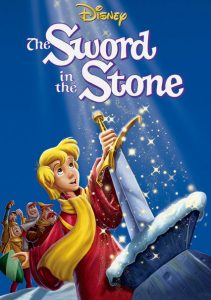The Sword in the Stone-1963
Director Wolfgang Reitherman
Voices Sebastian Cabot, Rickie Sorensen, Karl Swenson
Scott’s Review #896
Reviewed May 10, 2019
Grade: B
The 1960s, while not known as the best of decades for Walt Disney productions, offers a small gem of a film in The Sword in the Stone (1963).
Flying marginally under the radar, the film is not typically well-remembered but is a solid offering. It mixes elements of magic and royalty within a cute story.
The production has the dubious honor of being the final Disney animated film released before Walt Disney’s death.
While the film is not great, neither is it bad.
Engaging and innocent, it does not offer the ravaging tragedy of Bambi (1942), the emotion of Dumbo (1941), or the beauty of Snow White and the Seven Dwarfs (1937).
The Sword in the Stone offers an adventure with an appealing lead character, mildly entertaining supporting characters, and a host of fun antics surrounding education.
Set in ancient times, the King of England has died, leaving no heir to the throne. This situation elicits peril and worries, as the country is doomed to war with no successor.
One day, a miracle occurs, and an odd “Sword in the Stone” appears inside a sturdy anvil in London. The anvil’s inscription proclaims that whoever removes it will be the new king.
Despite many attempts, no strong citizens succeeded, and England was reduced to the Dark Ages, leaving the sword and the stone forgotten.
One day, a twelve-year-old boy named Arthur appears. He teams up with his tutor, Merlin the wizard, and the adventures commence.
Inevitably, Arthur can remove the sword from the stone and lead the Knights of the Round Table, accomplishing many amazing feats and becoming one of the most famous figures in history- King Arthur.
The Sword in the Stone entertains and pleases the eyes in many regards, with vibrant colors and an array of bells and whistles creatively interspersed throughout many scenes.
The main villain, Madam Mim, is Merlin’s main nemesis. Haggard and dripping with black magic powers, she can turn from a pink elephant into a queen with the flick of her wrist as she giggles and prances about.
Despite being dastardly, she is also fun and zany and delights in her brief screen time.
The whimsical antics of Merlin are the best aspects of The Sword in the Stone as the senior gentleman bursts and bumbles from one oddity to another in earnest attempts to aid Arthur.
Thanks to clever writing, an educational angle is robustly incorporated into the story. Merlin can see into the future, such as knowing that the world is round, not flat.
What a great learning tool the film provides for young kids to discover.
The story risks playing juvenile in some parts where I can see children under age twelve enthralled but adults finding the film too childish to take seriously.
Despite my efforts to stay tuned, I noticed tidbits of the film that seemed too cute.
When Merlin and Arthur are turned into squirrels and strike the fancy of adorable but clueless female squirrels, the scene seems best catered to very young audiences.
What would give the film some excitement would be a good, solid theme song or a powerful love story. Both aspects, which can solidify a hit for Disney, are glaringly missing.
Snow White and the Seven Dwarfs contain the lovely “Someday My Prince Will Come,” while Snow White and the Prince offer a rich love story.
While sound, The Sword in the Stone can only reach the second tier of Disney classics, missing the upper echelon with its only so-so musical offerings.
A slight miss is how Arthur’s voice changes back and forth between a child and a teenager going through puberty. This is drastically noticeable.
When analyzed, the reason is somewhat perplexing because three different actors were used to play Arthur, resulting in some consistency issues.
Why not just use one actor or age the character slowly and gradually deepen his voice? The back and forth feels sloppy.
The criticisms targeted at The Sword in the Stone (1963) are minor and forgivable as the film plays above average graded on its terms.
The film has a lovely message for children about the importance of education and is a delight best enjoyed by the whole family.
Oscar Nominations: Best Scoring of Music-Adaptation or Treatment
